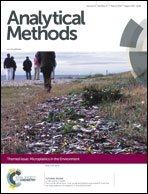Identification methods in microplastic analysis: a review
Abstract
Microplastics have become a major global environmental issue in recent decades due to their ubiquity in the oceans, bioavailability and ability to carry toxic chemicals. Analysis of microplastics in environmental and experimental samples has become increasingly common. We conducted a literature survey to review the current identification methods for microplastics. The advantages and limitations of each identification method were compared to indicate the best methods for microplastic analysis. Identification of microplastics is based on the physical and chemical characterisation of isolated particles in mixtures of inorganic and organic remnant particles after the extraction and clean-up steps. In addition, novel methods which may possibly be applied to microplastic identification were suggested. Microscopic identification by itself has a high risk of producing both false positive and false negative results in analyses of small microplastics. At present, combinations of physical (e.g., microscopy) and chemical (e.g., spectroscopy) analyses are widely used. However, there is a need to improve and develop new methods to reduce the identification time and effort and to detect sub-micron plastics in environmental samples.

- This article is part of the themed collections: Analytical Methods 2017 Most Downloaded Articles and Microplastics in the environment

 Please wait while we load your content...
Please wait while we load your content...